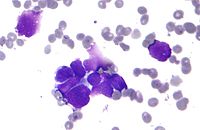
Photo from wikipedia
Microcystic, elongated, and fragmented (MELF) pattern invasion is a poor prognostic indicator in uterine endometrioid carcinoma, but its existence, biology, and prognostic value have not been described in ovarian endometrioid… Click to show full abstract
Microcystic, elongated, and fragmented (MELF) pattern invasion is a poor prognostic indicator in uterine endometrioid carcinoma, but its existence, biology, and prognostic value have not been described in ovarian endometrioid carcinoma. We evaluated cases of ovarian endometrioid carcinoma without synchronous uterine endometrioid carcinoma for MELF and other histologic features. To evaluate tumor biology, we assessed an immunohistochemical profile, including MLH1, PMS2, MSH2, MSH6, &bgr;-catenin, e-cadherin, CK19, and cyclin D1. A retrospective chart review evaluated clinical and demographic features and survival. The Fisher exact test analyzed data. The Kaplan-Meier method assessed overall survival. Forty-two patients met inclusion criteria. MELF was found in 45%. Two MELF cases showed MSH2/MSH6 deficiency and 2 conventional cases showed PMS2 deficiency. Clear cell features were seen exclusively in MELF cases (P-value=0.044). No difference was identified in overall survival, cancer recurrence, serous features, concurrent endometriosis, lymphovascular space invasion, lymph node metastasis, bilaterality of disease, extranodal metastasis, or remainder of immunohistochemical profile. MELF occurs at similar rates in ovarian endometrioid carcinoma and uterine endometrioid carcinoma and can be helpful in defining ovarian endometrioid carcinoma as it proves definitive invasion. Recurrence and overall survival in ovarian endometrioid carcinoma are not affected by MELF. Clear cell features are identified exclusively in MELF cases. Different mismatch repair proteins are lost in MELF compared with conventional ovarian endometrioid carcinomas. Given its association with clear cell features and mismatch repair protein loss, presence of MELF may be useful in clinical decisions regarding surgical staging and Lynch syndrome screening.
Journal Title: International Journal of Gynecological Pathology
Year Published: 2018
Link to full text (if available)
Share on Social Media: Sign Up to like & get
recommendations!